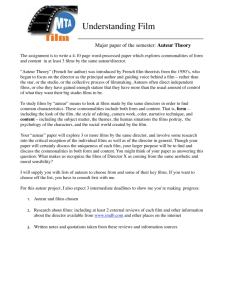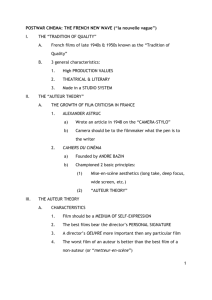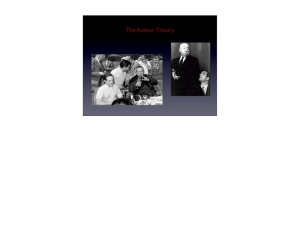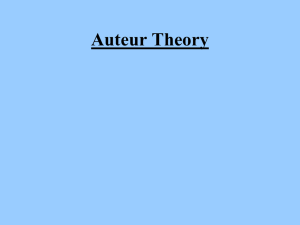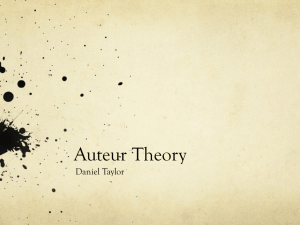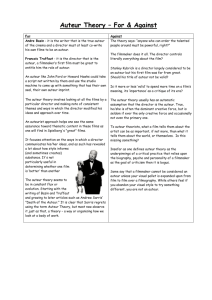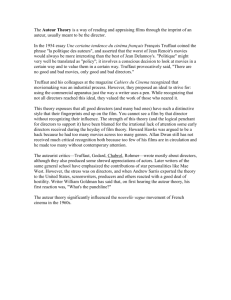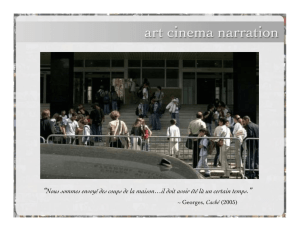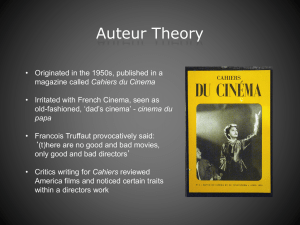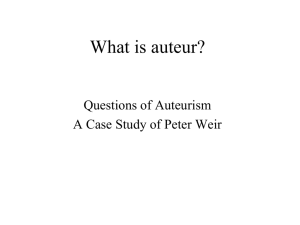Auteur Theory - Academic Csuohio
advertisement
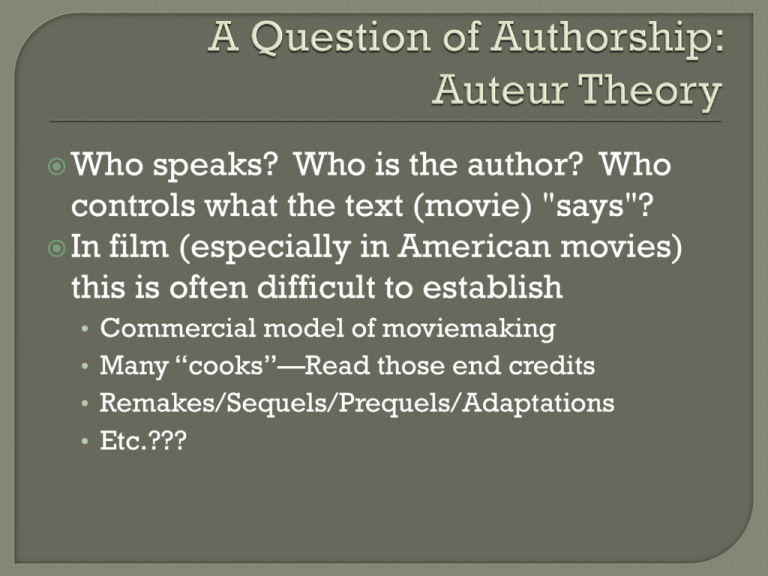
Who speaks? Who is the author? Who controls what the text (movie) "says"? In film (especially in American movies) this is often difficult to establish • Commercial model of moviemaking • Many “cooks”—Read those end credits • Remakes/Sequels/Prequels/Adaptations • Etc.??? l. Auteur theory developed by French writers in Andre Bazin's journal, Cahiers du Cinema during the 1950's (other theories--realism, genre theory) Andre Bazin 2. An auteur is noted to have a distinctive style and preoccupations-themes, visual & production styles, ways of handling scenes, etc. . . . recurring motifs • NOTE: Iconography = widely understood cultural symbols vs. Motif = recurring theme in a single film (or a set of films by same auteur) Check out the black leather jacket • NOTE: Iconography = widely understood cultural symbols vs. Motif = recurring theme in a single film (or a set of films by same auteur) Strangers on a Train • NOTE: Iconography = widely understood cultural symbols vs. Motif = recurring theme in a single film (or a set of films by same auteur) 3. Is an auteur always a director? • Auteur = director? • Auteur = star? • Auteur = screenwriter? 4. "Film-style" shooting gives the auteur artistic power 5. Can we identify an auteur empirically? • (Patrika Janstova, 2007 masters thesis, Cleveland State—the case of Jane Campion (The Piano, In the Cut) Content analysis of all 6 Jane Campion-directed films as of 2007 plus a matched sample of 18 “non-Campion” films (random sample of films matched on genre (drama), years, English language) Measured 56 form (techniques) and 113 substance (themes and character quality) variables • Campion films significantly: Fewer male leads More female and male nudity More sex (esp. oral sex and kissing) More often using female POV More physical and sexual abuse to opposite gender More identity change due to marriage, religion More instances of psychological disorder More characters traveling, living abroad, appearing lonely, Less non-diegetic music More closeups of face, hands, feet, arms, legs, touching More shots of mirrors, windows More slow motion More hand-held camera More use of color filters (red, blue) Greater presence of angels Tempering Auteur Theory with Reception Theory • Assuming an active audience • “The text proposes, the viewer disposes.” Let’s watch a portion of Hitchcock: The Man and His Movies (1975, D: Richard Schickel) Common Thematic Motifs • falsely accused man • "The villain doesn't kick the dog - - he's a charmer.“ • aloof blonde woman (e.g., Grace Kelly, Tippi Hedren, Eva Marie Saint) . . . sexual • • • • • • • • • • fire beneath a cool exterior malevolent crowd ironic use of religious symbols use of some important cultural artifact (a "safe" place) at the narrative climax (e.g., Albert Hall, Mt. Rushmore, Statue of Liberty, a train, a merry-go-round) "Film is life with the dull parts cut out.“ Carefully planned mise-en-scene (memorized his storyboards) Hitch's own cameo appearances--a gimmick Key production techniques . . . e.g., high-angle shots, canted camera angles, CUs, tracking shots Bomb theory of suspense Hitch's own fears & phobias MacGuffin theory of dramatic foils Let’s watch a portion of Buster Keaton: A Hard Act to Follow (1985, D: Kevin Brownlow) Common Thematic Motifs • The Keaton character - - stone-faced, he is considered a brainless idiot, & is kicked around (literally!) by others. . . but in all things perseveres & prevails. • The plot - - a young man courts a woman whose social position is more respectable than his own. Through ingenuity, & feats of daring & imagination, he wins her. (NOTE: Keaton did all his own stunts.) • Keaton's adversaries: machines & nature • Usual shot is LS, to show relation of man to natur
![[Lecture 17] Kiarostami for wiki 2012](http://s2.studylib.net/store/data/010226044_1-2bd9bf3346eddb7edb648289f56bc956-300x300.png)
